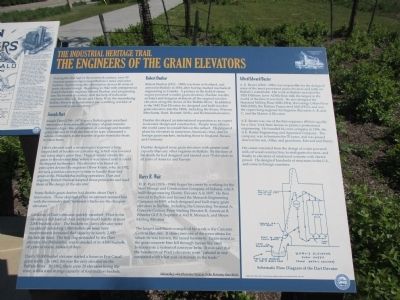First Ward in Buffalo in Erie County, New York — The American Northeast (Mid-Atlantic)
The Engineers of the Grain Elevators
The Industrial Heritage Trail
Joseph Dart
Joseph Dart (1799-1879) was a Buffalo grain merchant determined to increase the efficiency of grain transfer between ships. His construction of a storage and transfer grain elevator in 1842, the first of its type, eliminated a serious bottleneck in the transfer of grain from lake boats to canal boats.
Dart's elevator used a steam engine to power a long, looped belt of buckets on a marine leg, which was lowered out into a ship's grain bins. There it would elevate the grain to the elevator bins, where it was stored until it could be shipped further east. His elevator was based on principles devised by engineer Oliver Evans, who, in 1782, devised a similar conveyor system to handle flour and grain in his Philadelphia milling operation. Dart and engineer Robert Dunbar adapted those principles and used them in the design of the elevator.
Some Buffalo grain dealers had doubts about Dart's innovation. Those skeptical of his investment taunted him with the reminder that "Irishmen's backs are the cheapest elevators."
Criticism of Dart's elevator quickly vanished. Prior to his elevator, a full team of dock workers could handle at most 2,000 bushels a day. The buckets on Dart's elevator were capable of unloading 1,000 bushels an hour; later improvements increased that capacity to nearly 2,000 bushels an hour. The first ship unloaded by Dart elevator, the Philadelphia, was unloaded of its 4,600 bushels of grain in hours, instead of days.
Dart's 55,000 bushel elevator started a boom in Erie Canal grain traffic. In 1842, his was the only elevator in the Buffalo River. By 1862, there were 20 elevators lining the river, with a total storage capacity of four million bushels.
Robert Dunbar
Rober Dunbar (1812-1890) was born in Scotland, and arrived in Buffalo in 1834, after having studied mechanical engineering in Canada. A pioneer in the field of steam engine powered wooden grain elevators, Dunbar was the architect and designer of almost all the original wooden elevators along the shores of the Buffalo River. In addition to the 1842 Dart Elevator, he designed and built wooden grain elevators into the 1880s, including the Evans, Watson, Merchants, Reed, Bennett,
Wells, and Richmond elevators.
Dunbar developed an international reputation as an expert in elevator design and construction. People from all over the world came to consult him on the subject. He prepared plans for elevators in numerous American cities, and for foreign grain markets, including those in England, Russia, and Germany.
Dunbar designed more grain elevators with greater total capacity than any other engineer in Buffalo. By the time of his death, he had designed and erected over 75 elevators in all parts of America and Europe.
Harry R. Wait
H.R. Wait (1876-1946) began his career by working for the Steel Storage and Construction Company of Indiana, which built the pioneering Electric Elevator A in 1897. He then moved to Buffalo and formed the Monarch Engineering Company in 1909, which designed and built many grain elevators in Buffalo, including the Connecting Terminal A, Concrete Central, Perot Malting Elevator B, American B, Wheeler GLF B, Superior A and B, Monarch, and Meyer Malting Elevator.
The largest and finest example of his work is the Concrete Central Elevator. It showcases one of the innovations for which he was known, the raised basement. Grain stored in the great concrete bins fell through funnel-like steel bottoms into a system of conveyor belts. It was said the the basements of Wait's elevators were "palatial in size compared with what was customary in the trade."
[image] Unloading wheat into the Watson Grain Elevator, circa 1900.
Alfred Edward Baxter
A.E.Baxter (1860-1926) was responsible for the design of some of the most prominent grain elevators and mills on Buffalo's waterfront. His work in Buffalo included the 1924 Pillsbury (now ADM) flour mill, the largest in the world at the time it was built. He also designed the Standard Milling Flour Mill (1914), the George Urban Flour Mill (1903), the Ralston Purina feed Mill (1912), and was the supervising engineer for Superior Elevators A, B, and C, and the Marine A Elevator.
A.E. Baxter was one of the first engineers (#16) to qualify for a New York State license to practice professional engineering. He founded his own company in 1896, the A.E.Baxter Engineering and Appraisal Company. The company was in business for 70 years, and was passed down to his son, Allan, and grandsons Edward and Henry.
His career extended from the design of water powered mills of wood construction, to steel grain elevators, and finally to elevators of reinforced concrete with electric power. He designed hundreds of structures in the U.S., and some in foreign countries.
[image] Schematic Flow Diagram of the Dart Elevator. Image Source: Baxter, Henry. Grain Elevators. Buffalo and Erie County Historical Society, 1997 Print.
Topics and series. This memorial is listed in these topic lists: Industry & Commerce • Waterways & Vessels. In addition, it is included in the Erie Canal series list.
Location. 42° 51.529′ N, 78° 52.24′ W. Marker is in Buffalo, New York, in Erie County. It is in the First Ward. Memorial is on Fuhrmann Boulevard, ¼ mile south of The Skyway (New York State Route 5), on the right when traveling south. Touch for map. Marker is in this post office area: Buffalo NY 14203, United States of America. Touch for directions.
Other nearby markers. At least 8 other markers are within walking distance of this marker. The Grain Elevators (here, next to this marker); The Grain Industry Decline / Buffalo's Grain Legacy (within shouting distance of this marker); The First Grain Elevator / Early Grain Elevators (within shouting distance of this marker); The Early Grain Trade / Influence of the Erie Canal (about 300 feet away, measured in a direct line); Fireproof Grain Elevators / Concrete Grain Elevators (about 300 feet away); The Standard Elevator (approx. 0.2 miles away); The Wheeler / GLF Elevator (approx. 0.2 miles away); The Spencer Kellogg Elevator (approx. 0.2 miles away). Touch for a list and map of all markers in Buffalo.
Also see . . . Grain Elevator - Wikipedia. (Submitted on July 13, 2015, by Anton Schwarzmueller of Wilson, New York.)
Credits. This page was last revised on February 16, 2023. It was originally submitted on July 13, 2015, by Anton Schwarzmueller of Wilson, New York. This page has been viewed 404 times since then and 11 times this year. Photos: 1, 2. submitted on July 13, 2015, by Anton Schwarzmueller of Wilson, New York.

